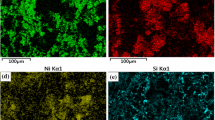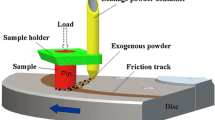Abstract
The effect of the coke and flake graphite ratio (C/F ratio) on the microstructure formation and properties of Cu-based friction materials was investigated. The density, hardness, friction coefficient, braking properties of the Cu-based friction materials with different C/F ratios were tested. The microstructures, wear morphology, and frictional subsurface of the Cu-based friction materials were characterized by SEM. With the increase in coke content, the proportion of flake graphite with long strips shape decreased, and the coke with clump shape increased. The density of Cu-based friction material decreased continuously with the increase in the C/F ratio. The hardness of the Cu-based friction material decreased first and then increased gradually with the increase in the C/F ratio. With the increase in C/F ratio, the friction coefficient increased, and the wear loss decreased. Moreover, during the braking process, the surface temperature of the Cu-based friction materials first increased and then decreased, and the braking time decreased first and then increased with the increase in C/F ratio. The wear mechanism of the Cu-based friction materials was abrasive wear, fatigue wear, and oxidative wear. The failure of the Cr-Fe particles was oxidation, crushing, and wear. Relatively, the Cu-based friction material with C/F ratio of 7/2 had high friction coefficient, low wear loss, low surface temperature during braking, and low braking time, which indicated better combination braking properties.
















Similar content being viewed by others
References
J. Xiao, S. Xiao, J. Chen, and C. Zhang, Wear Mechanism of Cu-Based Brake Pad for High-Speed Train Braking at Speed of 380 km/h, Tribol. Int., 2020, 150, 106357.
P. Zhang, L. Zhang, D. Wei, P. Wu, J. Cao, C. Shijia, X. Qu, and K. Fu, The Synergistic Effect of Cr and CrFe Particles on the Braking Behavior of Cu-Based Powder Metallurgy Brake Pads, Tribol. Trans., 2019, 62, p 1072–1085.
P. Zhang, L. Zhang, K. Fu, J. Cao, C. Shijia, and X. Qu, Effects of Different Forms of Fe Powder Additives on the Simulated Braking Performance of Cu-Based Friction Materials for High-Speed Railway Trains, Wear, 2018, 414–415, p 317–326.
H. Zhou, P. Yao, Y. Xiao, Z. Zhang, T. Gong, L. Zhao, M. Deng, A. Zhong, and Q. Wang, Interface Formation and Wear Mechanism between Characteristic Friction Components and Base Components of Cu-Based Powder Metallurgy Friction Materials, Chin. J Nonferrous. Met., 2016, 26, p 328–336.
L. Su, F. Gao, X. Han, R. Fu, and E. Zhang, Tribological Behavior of Copper-Graphite Powder Third Body on Copper-Based Friction Materials, Tribol. Lett., 2015, 60, 30.
Y. Wang, Q. Yan, F. Zhang, C. Ge, X. Zhang, and H. Zhao, Sintering Behavior of Cr in Different Atmospheres and its Effect on the Microstructure and Properties of Copper-Based Composite Materials, Int. J. Miner. Metall. Mater., 2013, 20, p 1208–1213.
H. Zhou, P. Yao, Y. Xiao, K. Fan, Z. Zhang, T. Gong, L. Zhao, M. Deng, C. Liu, and P. Ling, Friction and Wear Maps of Copper Metal Matrix Composites with Different Iron Volume Content, Tribol. Int., 2019, 132, p 199–210.
Y. Song, J. Fan, S. Wu, J. Liu, C. Zhang, and Y. Li, Effect of Carbon-Fiber Powder on Friction and Wear Properties of Copper-Matrix Composites, Mater. Sci. Tech., 2020, 36, p 92–99.
Y. Xiao, Z. Zhang, P. Yao, K. Fan, H. Zhou, T. Gong, L. Zhao, and M. Deng, Mechanical and Tribological Behaviors of Copper Metal Matrix Composites for Brake Pads Used in High-Speed Trains, Tribol. Int., 2018, 119, p 585–592.
X. Zhang, Y. Zhang, S. Du, Z. Yang, T. He, and Z. Li, Study on the Tribological Performance of Copper-Based Powder Metallurgical Friction Materials with Cu-Coated or Uncoated Graphite Particles as Lubricants, Materials, 2018, 11, 2016.
Z. Fan, Z. Xiang, D. Tan, B. Tang, Z. Li, J. Mo, and Z. Zhou, Wear Analysis of Brake Pad for CRH380A High-Speed Train, Tribology, 2020, 40, p 185–194.
H. Zhou, P. Yao, Y. Xiao, Z. Zhang, L. Chen, T. Gong, L. Zhao, and X. Zuo, Topographical Characteristics and Wear Mechanical of Copper-based Powder Metallurgy friction materials reinforced SiC particle, Chin. J Nonferrous. Met., 2014, 24, p 2272–2279.
P. Zhang, L. Zhang, S. Ren, K. Fu, P. Wu, J. Cao, C. Shijia, and X. Qu, Effect of Matrix Alloying of Fe on Friction and Wear Properties of Cu-Based Brake Pad Materials, Tribol. Trans., 2019, 62, p 701–711.
J. Fan, C. Zhang, S. Wu, D. Jia, L. Sun, Y. Li, and J. Liu, Effect of Cr-Fe on Friction and Wear Properties of Cu-Based Friction Material, Mater. Sci. Tech., 2018, 34, p 869–875.
I.J. Antonyraj, and D.L. Singaravelu, Tribological Characterization of Various Solid Lubricants Based Copper-Free Brake Friction Materials: A Comprehensive Study, Mater. Today proc., 2020, 27, p 2650–2656.
P. Zhang, L. Zhang, K. Fu, P. Wu, J. Cao, C. Shijia, and X. Qu, Fade Behaviour of Copper-Based Brake Pad During Cyclic Emergency Braking at High Speed and Overload Condition, Wear, 2019, 428–429, p 10–23.
X. Wang and H. Ru, Effect of Lubricating Phase on Microstructure and Properties of Cu-Fe Friction Materials, Materials, 2019, 12, 313.
B. Chen, Z. Yang, and J. Liu, Impacts of Carbon Fibers on Performance of Copper-based Friction Materials in Powder Metallurgy, Foundry Technol., 2017, 38, p 1304–1307.
A. Xie, C. Yin, X. Wang, and G. Wen, Tribology Behavior of Mesocarbon Microbeads-Copper Based Powder Metallurgy Friction Materials, Journal of Guangxi University, Nat. Sci. Ed., 2018, 43, p 2470–2477.
F. Gao, S. Du, R. Fu, and S. Bao-yun, Effects of Graphite Content on Performance of Copper-based Friction Materials, Min. Metall. Eng., 2005, 25, p 80–82.
P. Zhang, L. Zhang, D. Wei, P. Wu, J. Cao, C. Shijia, X. Qu, and K. Fu, Effect of Graphite Type on the Contact Plateaus and Friction Properties of Copper-Based Friction Material for High-Speed Railway Train, Wear, 2019, 432–433, 202927.
Y. Wang, Q. Yan, X. Zhang, F. Zhang, C. Ge, and H. Zhao, Effect of Graphite on Properties of Copper-Based Pads Materials Made by Powder Metallurgy, Powder Metall. Technol., 2012, 30, p 432–439.
Y. Fan, J. Zhang, Y. Gao, F. Wu, and B. Liu, The Influence of Graphite Particle Size on Friction and Wear Properties OF Copper-Ferrous Matric Friction Materials, Tribology, 2000, 20, p 475–477.
K. Li, X. Xiang, X. Bai, B. Liang, and W. Gong, Effect of Particle Size and Copper-Cated Graphite Content on Properties of the Cu/Copper-Coated Graphite Compose, Met. Funct. Mater., 2016, 23, p 47–50.
M. Leonardi, M. Alemani, G. Straffelini, and S. Gialanella, A Pin-on-Disc Study on the Dry Sliding Behavior of a Cu-Free Friction Material Containing Different Types of Natural Graphite, Wear, 2020, 442–443, 203157.
H. Cao, Z. Tan, G. Fan, Q. Guo, Y. Su, Z. Li, and D. Xiong, Wide and Fine Alignment Control and Interface Modification for High-Performance Thermally Conductive Graphite/Copper Composite, Compos. B. Eng., 2020, 191, 107965.
X. Xiong, J. Chen, P. Yao, S. Li, and B. Huang, Friction and Wear Behaviors and Mechanisms of Fe and SiO2 in Cu-Based P/M Friction Materials, Wear, 2007, 262, p 1182–1186.
S. Wen, P. Huang, Y. Tian, and L. Ma, Principles of Tribology, Tsinghua University Press, Beijing, 2018.
K.Z. Gahr, Microstructure and Wear of Materials, Elsevier, The Netherlands, 1987.
X. Zhao, J.J. Hao, X. Yu, K. Peng, and Z.M. Guo, The Wording of Ferrochrome in Copper-Based P/M Friction Material, Appl. Mech. Mater., 2014, 442, p 110–115.
Acknowledgments
This work was supported by the Natural Science Foundation of Henan Province in China (Grants No: 222300420584), Postgraduate Education Reform and Quality Improvement Project of Henan Province (YJS2021AL026), the National Natural Science Foundation of China (Grants No: U1904175), the Young Teachers Training Program of Henan Province Higher Education Institutions (Grant No: 2018GGJS090), Zhengzhou Major Science and Technology Innovation Project (Grant No: 2019CXZX0065).
Author information
Authors and Affiliations
Corresponding author
Ethics declarations
Conflict of interest
The authors declare that they have no conflict of interest.
Additional information
Publisher's Note
Springer Nature remains neutral with regard to jurisdictional claims in published maps and institutional affiliations.
Rights and permissions
About this article
Cite this article
Fan, J., Wang, N., Wang, X. et al. Effect of the Coke/Flake Graphite Ratio on the Microstructure and Properties of Cu-Based Powder Metallurgy Friction Materials. J. of Materi Eng and Perform 31, 10378–10392 (2022). https://doi.org/10.1007/s11665-022-06998-9
Received:
Revised:
Accepted:
Published:
Issue Date:
DOI: https://doi.org/10.1007/s11665-022-06998-9




